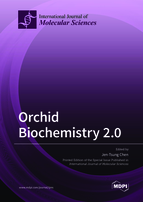Orchid Biochemistry 2.0
A special issue of International Journal of Molecular Sciences (ISSN 1422-0067). This special issue belongs to the section "Molecular Plant Sciences".
Deadline for manuscript submissions: closed (20 March 2022) | Viewed by 39748
Special Issue Editor
Interests: bioactive compounds; chromatography techniques; medicinal plants; phytochemicals; plant biotechnology; plant growth regulators; plant secondary metabolites
Special Issues, Collections and Topics in MDPI journals
Special Issue Information
Dear Colleagues,
This Special Issue is the continuation of our previous special issue "Orchid Biochemistry".
Orchidaceae is one of the largest families among the angiosperms and is represented by approximately 25,000–28,000 species worldwide across a wide range of habitats. Orchids are well known for their attractive flowers and have high economical value in the global horticultural market. What often receives less attention is the fact that some orchids are edible or scented, and more than this, many species have long been used in preparations as traditional medicine. In the past two decades, extensive studies have been carried out on genetic and functional genomic analysis to achieve progress in biotechnology and breeding programs for orchids. However, in-depth research on the bioactive compounds of orchids is still limited to several species.
In order to address the lack of phytochemical knowledge, this Special Issue aims to integrate recent innovative approaches and attempts to make significant progress in orchid biochemistry by expanding knowledge on a wide range of topics, including biosynthetic machinery, pharmacognosy, biotechnology, and high-throughput technologies, including bioinformatics and other related topics.
Dr. Jen-Tsung Chen
Guest Editor
Manuscript Submission Information
Manuscripts should be submitted online at www.mdpi.com by registering and logging in to this website. Once you are registered, click here to go to the submission form. Manuscripts can be submitted until the deadline. All submissions that pass pre-check are peer-reviewed. Accepted papers will be published continuously in the journal (as soon as accepted) and will be listed together on the special issue website. Research articles, review articles as well as short communications are invited. For planned papers, a title and short abstract (about 100 words) can be sent to the Editorial Office for announcement on this website.
Submitted manuscripts should not have been published previously, nor be under consideration for publication elsewhere (except conference proceedings papers). All manuscripts are thoroughly refereed through a single-blind peer-review process. A guide for authors and other relevant information for submission of manuscripts is available on the Instructions for Authors page. International Journal of Molecular Sciences is an international peer-reviewed open access semimonthly journal published by MDPI.
Please visit the Instructions for Authors page before submitting a manuscript. There is an Article Processing Charge (APC) for publication in this open access journal. For details about the APC please see here. Submitted papers should be well formatted and use good English. Authors may use MDPI's English editing service prior to publication or during author revisions.
Keywords
- Biochemistry
- Bioinformatics
- Biosynthetic machinery
- Flower scent
- Gene expression
- Genomics
- High-throughput technologies
- Metabolomics
- Orchid
- Pharmacognosy
- Pharmacology
- Proteomics
- Traditional medicine
- Transcriptomics
Related Special Issue
- Orchid Biochemistry in International Journal of Molecular Sciences (33 articles)







